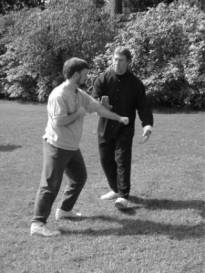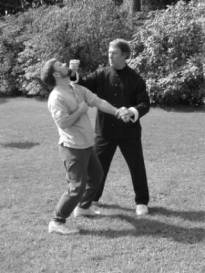 Gilman Studio On-Line Lessons
Gilman Studio On-Line Lessons
Yang Style Long Form
Tai Chi Chuan
This Lesson Contains:
Movement # 16 – Left Brush Knee
Movement # 17 – Step Up, Parry, and Punch
Movement # 16 – Left Brush Knee
This movement is a repeat of Movement #12, done in exactly the same way. Make a copy of that lesson and put it here so you will have a continuous pictorial study guide.
Movement # 17 – Step Up, Parry, and Punch
This is quite a complicated movement, so there will be many pictures to help me illustrate how to do it. The basic idea is that the opponent attacks the center with his left fist. I neutralize it to the left side, step up and deliver a right back fist strike and follow it up with a left palm strike. Opponent falls back and I follow him and deliver a right fist to his center. This series of attacks following a defensive move is quite typical of the martial arts. It is like a great river that keeps flowing ever onward no matter what obstacles are placed before it. Remember, this movement starts at the end of the previous movement, Left Brush Knee, when I am forward on the left foot. My left toe and my body face slightly to the left of west. I hope the change of perspective between the form pictures and the application pictures does not confuse you. I did it so you could more easily see the applications, and what the hands are doing.

 Rex attacks my center with his left fist.
Rex attacks my center with his left fist.
Shift the weight back into Ding Bow on Left Heel, and as you do, turn the body slightly to the left. Right hand moves down slightly to the left, palm facing down. Left palm turns over to face upward. It is starting to come up in order to be available for defense or offense.
It is important to turn the torso slightly to the left in order to be moving with the punch should it land. When joining with the incoming punch, do not push the opponent’s hand out of the way. Lead it down and to the left, which causes the opponent to over extend.
Focus on the right palm for neutralizing.

 I have now grabbed Rex’s arm and am adding a pull to upset his balance.
I have now grabbed Rex’s arm and am adding a pull to upset his balance.
Shift the weight to the left foot and when the knee covers the toe, roll up the rear foot onto the toe in order to step, block, or kick.
In the form, the left hand has come up to the left side of the chest and the right hand has continued down to waist level, basically center position.
In application, the left hand has grabbed opponent’s wrist and added a bit of pull, while the right hand is ready to defend or strike.
Focus on the left palm for a pull.

 I now step to the side of Rex and strike him with a right back fist.
I now step to the side of Rex and strike him with a right back fist.
Step ahead with the right foot slightly to the right of west. Form a fist with the right hand and strike out by pivoting from the elbow, making a half circle, ending with the fist about level with your lower face. The left hand stays about the same. Do not shift the weight all the way onto the right foot yet. When you strike with the back fist, your weight should be slightly less then half way onto the right foot.
Focus on the right back fist and the left palm for pulling.
Most of the time when we punch in Tai Chi, we use an opposing pull with the other hand in order to keep the opponent from moving away and so the force of the punch will be absorbed into the body.

 I follow up with a left palm strike.
I follow up with a left palm strike.
Continue to shift the weight onto the right foot until the knee just covers the toe and the nose points to the knee. The right fist has continued down and ends up at the right side of the waist. At the same time the left palm extends out on the left side of the chest. Keep the elbow drooped.
Note about the Tai Chi fist: It is held loosely, but firmly closed. It is like holding a bird in your hand – firm enough not to allow it to fly away, yet loose enough not to crush it. Only at the moment of contact would the fist become hard, and then immediately it would soften again.

 I am now stepping forward.
I am now stepping forward.
Sink the weight even more into the right Kua (hip area) and turn out the right foot slightly by pivoting on the heel. This is done to gather more energy into the right side for later release. The left foot steps straight forward (west) with the heel just touching down. Do not put any weight on this foot yet. Do not move off your right foot root. The left hand turns to face the right and relaxes somewhat. The right fist does not change.

 The right fist punches opponent’s chest.
The right fist punches opponent’s chest.
Shift the weight onto the left foot until the knee covers the toe. Body faces forward. The right fist extends outward and makes a half twist, ending up in the center of the chest. Keep the elbow drooped. The left palm is pulled back and ends up facing the right elbow. Do not lean or turn too much to the left. The body should face straight ahead.
The punch actually comes from the left side of the body retreating (the left hand pulls back). The punch comes up from the ground, is amplified by the stored energy in the right Kua, moves up to the waist and back, and is released from the right fist. It is this twisting of the waist that makes the punch powerful. The punch does not come from the shoulder, but from the whole body.
